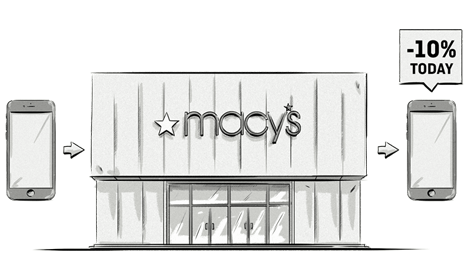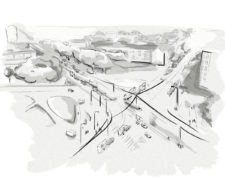Marketers have a problem with mobile – or more precisely, with mobile shoppers. And the problem is this: nearly two-thirds of the purchases that people make based on a mobile search take place offline.
That means a whole lot of us like to search for goods and services on our smartphone or tablet and then make our final decision in person – either over the phone or in a store.
Not so strange, perhaps, but maddening for marketers who desperately want to be unravel the mystery of where those conversions come from and be able to attribute them to the first digital point of contact. In other words, offline attribution.
Is there a solution? Maybe.
It’s called beacons.
What are beacons?
Originally, the brainchild of Apple, who first developed and standardized the idea of a low energy-consuming, Bluetooth-based device to communicate with mobile phones and tablets, beacons have become quite popular over the last several years.
When placed within a brick-and-mortar retail store, a beacon lets brands recognize mobile devices who have been previously associated with them (by downloading a store’s mobile app, for instance) and interact with them in real-time.
So a visitor, upon entering a store, could receive a notification to his or her smartphone with a special coupon or alert about a new line of products. He or she could also use the connection through a store’s beacon locate items or even check out.
Beacons are finding their usefulness in a wide range of business applications. Airlines, including American Airlines are using them to help travelers at airports, hotels are implementing them as part of an advanced customer service system, and cinemas are starting to use them to engage theater-goers.
Beacons for mobile marketing
And yet, marketing is where beacons hold the greatest potential. That is why Business Insider estimates that this year beacons will drive $44 billion worth of sales or more than 10 times the amount they influenced last year.
That is also why some of the biggest names in merchandising have invested considerable time and effort into making them a part of their brick-and-mortar operations. Obviously the technology has great value.
Part of what makes it valuable is being able to offering a more personalized experience for customers.
The push for personalization in modern marketing has been well-documented and beacons make it possible in real-time, when customers are actually on-site and most likely to convert. Coupons and special offers can be tailored to individuals who have made previous purchases.

When customers are signed up for a retailer’s loyalty program and have the store’s app running on their smartphone, they can receive a special one-time-offer redeemable on the spot while they shop. This sort of incentive not only drives sales, but also encourages store visitors to remain connected while shopping, helping marketers gather more information for later use.
This also helps with the other area where beacons are set to make a big impact – solving the offline attribution puzzle.
Closing the loop with beacons
As mentioned earlier, the real holy grail of beacons for marketers, is being able to understand what online marketing campaign contributed to offline purchases.
And with more and more adoption of beacons for various purposes and cross-device tracking technology, the pieces are available to make it happen.
Here’s how this can happen:
- By recording the ID of mobile devices where in-app ads are served and comparing it to the in-store traffic picked up by beacons, it is possible to identify customers who visited a store after having been exposed to mobile ad campaigns. When the same customer takes advantage of a beacon-triggered coupon to make his or her purchase, it is even possible to attribute sales to the mobile ads which were served.By the same token, this process can be revered for the purposes of retargeting. When the beacon system recognizes that previous store visitors haven’t returned for a certain period of time, a retargeting campaign can be triggered with special offers, discounts and other personalized content to bring them back.
- Some new beacon-based systems such as Yext, provide solutions that are not based on one single application but rather a wider network of application. After engaging customers with various kinds of information – not just sales promotions and ads – and building a rich bank of customer data, this information can then be synced to ad servers like Facebook and used for retargeting. As the cycle of on-location connections and online ads continues, the attribution loop closes more and more.
One obvious and persistent problem, of course – is that consumers must allow themselves to be discovered – via Bluetooth or a brand’s mobile app. That can potentially be a big limitation, especially when it comes to the actual number of customers that can be retargeted or attributed.
But there is still great potential, especially if the major smartphone companies like Apple and Google start building in beacon-enabled apps to their operating systems.
This is why the first use case for beacons – serving promotions, coupons, inviting users to participate in surveys etc – may eventually unlock the possibility of achieving true success with offline attribution. The more people are inclined to engage with brands over mobile channels while shopping in-store, the more they will be open to letting their devices interact with beacon systems.
As beacons and connected objects become more and more commonplace, it is likely that barriers to sharing location information will decrease.
And that will be the day when beacons really come into their own.








